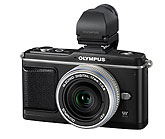 Micro Four Thirds fans, listen up! The Olympus E-P2 digital camera has landed and Olympus sent me one to check out for a few days before they made the announcement! Its predecessor, the Olympus E-P1 was one of the surprise hits of the summer. The Olympus E-P2 is more or less the same camera as the E-P1 with a few important new features. The most obvious difference is the sexy new black finish. But it goes deeper than that. Most important is the new Accessory Port and included Articulating EVF (electronic viewfinder). The rest of changes are internal. They include auto focus tracking (yes – it works in Movie Mode, too!), manual exposure control in movie mode, two new Art Filters and a new Picture Mode.
Micro Four Thirds fans, listen up! The Olympus E-P2 digital camera has landed and Olympus sent me one to check out for a few days before they made the announcement! Its predecessor, the Olympus E-P1 was one of the surprise hits of the summer. The Olympus E-P2 is more or less the same camera as the E-P1 with a few important new features. The most obvious difference is the sexy new black finish. But it goes deeper than that. Most important is the new Accessory Port and included Articulating EVF (electronic viewfinder). The rest of changes are internal. They include auto focus tracking (yes – it works in Movie Mode, too!), manual exposure control in movie mode, two new Art Filters and a new Picture Mode.
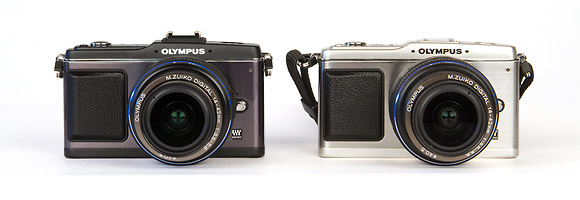
The E-P2 is more a refinement of the E-P1 than a brand new camera. The E-P2′s basic specs and design are pretty much the same as the E-P1. Both cameras use the same 12-megapixel sensor so video and still image quality should be the same. And other than a slightly higher top to accommodate the Accessory Port and the transparent black finish, the camera body is also the same. According to Olympus, one of the things people didn’t like about the E-P1 was that it wasn’t available in black. Personally, I like the metallic stainless steel body – it’s different. But some people just need to be seen wearing tough guy black. And now they can, with the Olympus E-P2.
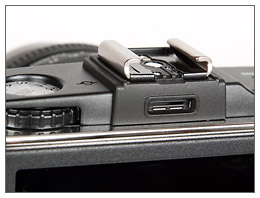 |
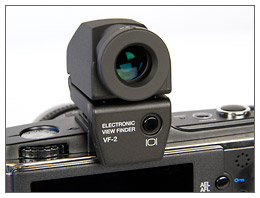 |
|
| Olympus E-P2 Accessory Port (L) and new Articulated EVF (R) | ||
Olympus E-P2 Accessory Port
One of the critical differences between the original Olympus Digital Pen and the E-P2 is the new Accessory Port, located on the back of the camera just below the accessory/flash shoe. The new electronic viewfinder slides into the accessory shoe and connects to the camera via the Accessory Port. The EVF (electronic viewfinder) is a useful addition for shooting in bright light, shooting at difficult angles and following action (panning). And unlike Panasonic’s new GF1 Micro Four Thirds camera, the Olympus EVF unit is included with the camera kit. If you buy the Panasonic GF1, their optional EVF will cost you an extra two bills ($200). The EVF will help photographers track moving subjects better but it won’t transform the E-P2 into a serious action camera. I have yet to use an EVF camera that didn’t have significant blackout between shots in burst mode. But your first panning shot will be better than it would have been using just the rear LCD display. Besides the EVF, the new Accessory Port will also accommodate an external microphone. Olympus makes a couple of microphones including a remote stereo mic and there are plenty of third-party options. The E-P1 captures surprisingly good video so the addition of external stereo sound, full manual video exposure control and auto focus tracking will make the E-P2 an even better compact video capture tool.
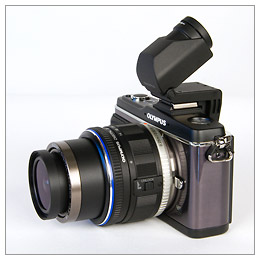 |
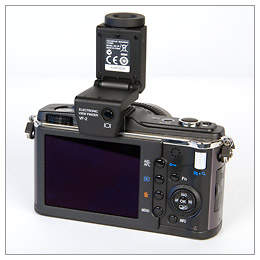 |
|
| Two views of the new Olympus E-P2 and Articulated EVF | ||
Olympus E-P2 Auto Focus Tracking
The new auto focus tracking is easy to miss at first but I think it’s the E-P2′s coolest new feature. It behaves very much like face detection, with a focus box that follows the subject, once it’s locked. Like face detection, exposure is tied to the focus point to ensure your subject is the exposure priority. Auto focus tracking works in the movie mode as well as for stills and that will likely be where it’s most valuable – for filming unpredictable moving subjects like kids and pets. I don’t know if it will satisfy critics of the Olympus Digital Pen auto focus speed. But it should make it easier to get stills and video of unpredictable moving subjects. I shot a video clip of the new C-AF auto focus tracking in action because I think it’s better to demonstrate it than try to describe it. The video won’t be done when this story goes live but I will post it soon.
next page – Olympus E-P2 New Art Filters and Conclusion >>



That would be a tight camera for travel shooting.
-M
“Besides the EVF, the new Accessory Port will also accommodate an external microphone.”
Do you mean it will do both at the same time?
Or it’s one or the other?
“a focus box that follows the subject, once it’s locked.”
Just like the GH-1 already has, and if it’s as slow as the GH-1 it’ll be almost unusable for anything moving at speed.
I tried the GH-1 on birds in flight, and on cars – failure on both. The problem was mainly the time it takes to identify and lock on the target, with both by the time it’s locked the subject’s gone by.
The GH-1 works for an active cat (or maybe kittens) in a confined area, like running about the room in front of you, so I think it does what it’s intended.
I expect the E-P2 will have similar performance.
Maybe I shouldn’t have got the E-P1 immediately … this has most of the features I wanted that make up for the lack of a tilt/swivel screen on the GH-1.
Oh well there’s never a good time to buy a new camera, and early adopters always pay for it somehow – I know that.
Paul-
Thanks for asking about the Accessory Port. I asked Olympus the same question and forgot to inlcude that detail in the article. No, you can’t use the EVF and an external mic at the same time. You have to choose one or the other.
I still haven’t used the GH1 so I can’t comment on auto focus tracking with it. I also can’t comment on the performance of the E-P2 AF tracking since the camera I had was a pre-production unit. All I know is it seems pretty cool. However, based on my experience with the Panasonic G1 and the Olympus E-P1 and other reports on the Web, I don’t think any Micro Four Thirds camera is a suitable tool for action shooting. The auto focus systems just aren’t up to par when compared with even the lowliest digital SLR.
Pingback: Olympus E-P2 video | Fotografia e Web Marketing